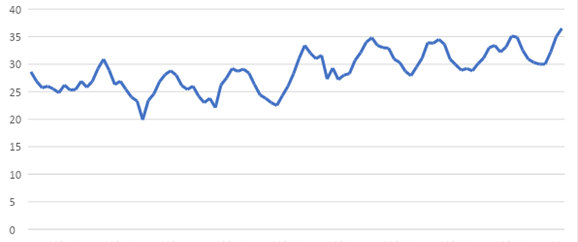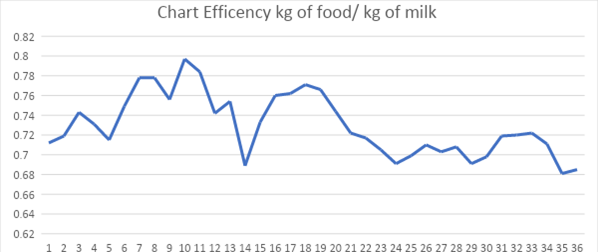The story of the
leading dairy farm in Vietnam
.
at-the-work: Israeli technology, management &
methods localized to Vietnam
dairyfrsh.asia
case-study
20 May 2021
01
FAILED TO OPERATE
' The story of the farm which had an imported quality cows & foreign plans, but failed to fit Vietnam conditions and be profitable.
A new foreign management with dairyfresh.asia understood the technology & management requirements & turn the farm from 10Kg to 36Kg becoming de-facto the number one, in milk yield and profitability, private farm in Vietnam '
This dairy was part of a national Vietnamese milk project in a distant and hot province in Vietnam, this specific dairy was owned by a government company and the planning was done by foreigners, the dairy was operated for several years by the local company. The cows were high quality cows originally imported from Australia, however, although the well planned farm and quality herd, the the local team was unable to cope with the objective challenges of milk production in a tropical country, heat , health and more, and the dairy went bankrupt. It is a challenging task to successfully manage a commercial dairy farm with all aspects of construct, logistics, animal feed, health, reproduction, quality, finance , employees, and the knowledge required to do it right first time. Every wrong decision taken can lead to catastrophic financial or operational impact on the farm. Specifically in southeast Asia and Vietnam the environmental and business landscape made it even more challenging.
02
A NEW BEGINING WITH TECH & MANAGEMENT FROM ISRAEL TO ACHIVEING THE HIGHEST MILK YIELD IN COUNTRY
An investors arrived in time to purchase the dairy and began the rehabilitation program. The farm was purchased in a state where cows are malnourished, the only food available to them was elephant grass, and the tropical grass did not have enough nutritional values to produce milk, the average milk per cow was 10 liters on the day of purchase.
There were close to 500 cows in the farm, but half of them could not be rehabilitated and it was decided to sell them. New investment was made in a milking parlor, cooling systems and tractors, a new foreign management and consulting from Israel began rehabilitating the farm. The recovery of the farm was exceptional, within a year of building the institute, by improved nutrition, improving the cooling and ventilation in the sheds and at the milking parlor. In 2015 dairyfresh.asia joined the operation of the farm and after a year of joint operation , the owners decided to make the other experts redundant and give us the management and feeding of the farm where it reached impressive milk production levels of close to 30 liters per cow.
This year was a challenging year, a year of adjustments, as the company moved to sell milk from one processing plant to another , the move had to make many dietary adjustments to the new processing plant more stringent quality requests , a dairy whose raw food was based on tropical grass, we had to switch to corn silage to obtain the full quality of the milk, which was mostly based on an SNF standard that is difficult to achieve when basing the ration on grass, the most effective way is to base the ration on corn which is a source of starch that helps increase the SNF in milk
03
MEETING HIGHER QUALITY DEMAND , THAT ALSO LEADS TO HIGHER PROFITABILITY
In early 2017 the processing plant make its quality requirements much tougher.
They increase the continuum of somatic cells from 600 to 400 , which means that our farm with the average of over 400,000 somatic cells, that was considered great quality just few weeks before, will not get from now on the full price for milk, this was a serious threat to the profitability of the farm.
Due to problems in the operation of the free-stalls in the farm at that time , the somatic cells count stood at 600 thousand liters of somatic cells per cow, and as the request from processing plant was to be achieved the improvements in two months notice, the task was challenging.
in order to meet the standard, we went into a two-month operation, set up a local laboratory for bacteriological tests and somatic cells, we did individual tests for each cow to understand from the cows that contribute to the high average of cells in the tank, we divided the cows into several groups.
The one group with very problematic cows we just sold, a second group treated or separated the milk from the infected quarter, a third group dried a very sick quarter that could not be treated, and a fourth group close to drying before calving dried. In addition, we introduced a protocol of monthly somatic cell testing.
With all above efforts and technologies, we managed to lower cells from 600 to 350 within a month and get the maximum price for milk also in early 2017, it was clear at the same point that the free stalls would have to be treated better in order to achieve good results in the future, but since many cowsheds in Vietnam failed to meet the standard of 400,000 processing-plant somatic cells it was decided after 2 months to return the old standard, and the investors decided to postpone the investments in the free-stalls.
04
MILK PRODUCTIVITY BREAKTHROUGH INCREASE FROM 23 KG TO 34 KG
by end of 2017 we improved the quality and quantity of corn silage in the farm, purchased a unique machine for making silage in the sleeves, took us time and a lot of adjustments to learn working with the machine in an efficient manner but at the end the necessary adjustments were made to Vietnam conditions and thereby significantly improved the quality and quantity the milk for the cow in the herd. This year we also improved the quality of cooling between milkings, and by doing so we improved summer milk, introducing of free-stalls with bedding was key.
Over the years one of the weaknesses of the farm was the care and operation of the free-stalls which had sand. The first problematic point was that the cells were old and the cows easily broke the iron that forms the separation between the cows, so in a large part of the breeding areas cows lay in whatever position they wanted inside the cells. And the urine of cows entered the cells, the second point was that the sand was filled and recycled manually, which meant that there was always a lack of sand in the cells and the sand was not clean enough for reuse in the cows. There was a decision to be taken whether to continue working with sand or switch to other methods which are easier and cheaper to operate, with less work in the care of the cells, after examining all the options, we came to the conclusion that we need to continue with the sand and improve the treatment of the cells, both in terms of recycling and in terms of dispersing the sand in the cells.
In 2018 the improvement in the quality of the compound food, led to greater use of compound food at the expense of a imported TMR, we released many food supplements designed to support the ration because of poor quality of the compound food, by improving the compound food, removing the unnecessary supplements from the ration, we managed to significantly reduce the ration price, also because the ration was more balanced with higher quality compound food the food utilization of the cows improved, the cows produced more milk with less food and the cash flow of the farm improved miraculously.
All of these improvements were aligned with monitoring every aspect of the cows and farm using sensors, cameras and analytics software, its crucial to personalize each cow as well as see daily issues and performance of the farm as a whole as seen in the chart below:

Below are real results in Vietnam:Milk production from 23 Kg per cow in 2016 to 34 Kg in 2020

05
FINE TUNING TO INCREASE MILK TO THE COUNTRY HIEGHEST RECORD OF 36 KG AND IMPROVE PROFITABILITY
In 2019 we concentrated on improving the breeding conditions of cows, invested considerable effort and money in cow-comfort in the farm, the above improvement led to improvement in all parameters of the farm, the amount of mastitis decreased steeply from 50 infections per day to less than 20 per day (less From 3% per month, compared to the other dairy farms in Vietnam the average ranges from 6% to 10% of the milks have infections per month!), The milk increased significantly from the moment we treated the cows comfortably, the project started working and straight showed significant improvement in results. The conditions and cows responded more and more milk, another statistic that improved was fertility, cows were healthier and therefore moved more easily.
2019-2020 continued the trend of improvements in the farm productivity as seen in below chart:

The main points we focused in this years is to improve the farm profitability. As feeding has the highest cost factor, we focus on improving it in the last 2 years, by lowering food price by producing of a cheaper ratio without compromising on quality in order to reduce unnecessary costs and on the other hand try and improve food utilization i.e. in order to produce 1 liter of milk the cow today eats less food than she ate a year or two ago as seen in chart below, we imply different technologies and know how.

The milk output of the farm increased from year to year, without the need to purchase or import expensive cows, all was based on a natural increase of the herd and an increase in milk per cow as seen in the chart below.
